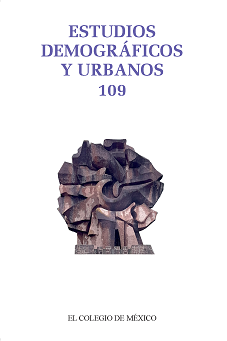Esperanza de vida en torno a la joroba de mortalidad masculina en México, con suavizamiento controlado por segmentos
Publicado 2022-03-03
Palabras clave
- mortalidad,
- tendencia,
- esperanza de vida temporal,
- suavizamiento controlado,
- joroba de mortalidad
Cómo citar
-
Resumen1757
-
PDF (español)437
-
En línea (español)68
-
EPUB (español)30
-
Kindle (español)92
-
Audio (español)5
Descargas
Derechos de autor 2022 Estudios Demográficos y Urbanos

Esta obra está bajo una licencia internacional Creative Commons Atribución-NoComercial-SinDerivadas 4.0.
Métrica
Resumen
En este artículo se estima la esperanza de vida temporal en torno a la joroba de mortalidad masculina para México a nivel estatal, para los años 2000, 2005, 2010 y 2015. Se optó por el método de suavizamiento controlado por segmentos, con la finalidad de garantizar la comparabilidad y mitigar el efecto que pudieran tener observaciones extrañas, en función de lo esperable en cuanto a la mortalidad subyacente. Se compara la eficacia del método propuesto frente a modelos paramétricos de la literatura y destaca el presente. Los resultados indican que dicha esperanza de vida temporal es desigual y en algunos casos menor que la del año 2000, además de evidenciar el mejor ajuste que logra la presente propuesta frente a varios modelos paramétricos de mortalidad, tales como el de Heligman y Pollard.
Referencias
- Aburto, J., Beltrán, H., García, V. y Canudas-Romo, V. (2016). Homicides in Mexico reversed life expectancy gains for men and slowed them for women, 2000-10. Health Affairs, 35(1), 88-95. https://www.healthaffairs.org/doi/pdf/10.1377/hlthaff.2015.0068 DOI: https://doi.org/10.1377/hlthaff.2015.0068
- Aburto, J., Riffe, T. y Canudas-Romo, V. (2018). Trends in avoidable mortality over the life course in Mexico, 1990-2015: A cross-sectional demographic analysis. BMJ Open, 8, 1-11. https://bmjopen.bmj.com/content/bmjopen/8/7/e022350.full.pdf DOI: https://doi.org/10.1136/bmjopen-2018-022350
- Arriaga, E. (1984). Measuring and explaining the change in life expectancies. Demography, 21(1), 83-96. https://link.springer.com/article/10.2307/2061029 DOI: https://doi.org/10.2307/2061029
- Arriaga, E. (1996). Comentarios sobre algunos índices para medir el nivel y el cambio en la mortalidad. Estudios Demográficos y Urbanos, 11(1), 5-30. https://estudiosdemograficosyurbanos.colmex.mx/index.php/edu/article/view/962/955 DOI: https://doi.org/10.24201/edu.v11i1.962
- Blum, R. W. (2009). Young people: Not as healthy as they seem. The Lancet, 374(9693), 853-854. https://www.thelancet.com/journals/lancet/article/PIIS0140-6736(09)61607-X/fulltext DOI: https://doi.org/10.1016/S0140-6736(09)61607-X
- Camarda, C., Eilers, P. y Gampe, J. (2016). Sums of smooth exponentials to decompose complex series of counts. Statistical Modelling, 16(4), 279-296. https://journals.sagepub.com/doi/abs/10.1177/1471082X16641796 DOI: https://doi.org/10.1177/1471082X16641796
- Carriere, J. (1992). Parametric models for life tables. Transactions of the Society of Actuaries, 44, 77-99. https://www.soa.org/globalassets/assets/library/research/transactions-of-society-of-actuaries/1990-95/1992/january/tsa92v446.pdf
- Dávila, C. y Pardo, A. (2013). Análisis de la tendencia de la mortalidad por homicidios en México entre 2000 y 2010. Gerencia y Políticas de Salud, 12(24), 163-183. http://revistas.javeriana.edu.co/index.php/gerepolsal/article/view/6099
- González, G., Vega, M. y Cabrera, C. (2012). Impacto de la violencia homicida en la esperanza de vida masculina de México. Revista Panamericana de Salud Pública, 32(5), 335-342. https://scielosp.org/pdf/rpsp/2012.v32n5/335-342/es DOI: https://doi.org/10.1590/S1020-49892012001100003
- Gompertz, B. (1825). On the nature of the function expressive of the law of human mortality, and on a new mode of determining the value of life contingencies. Philosophical Transactions of the Royal Society of London, 115, 513-583. https://www.jstor.org/stable/pdf/107756.pdf DOI: https://doi.org/10.1098/rstl.1825.0026
- Guerrero, V. M. (2007). Time series smoothing by penalized least squares. Statistics and Probability Letters, 77(12), 1225-1234. https://www.sciencedirect.com/science/article/abs/pii/S0167715207000855?via%3Dihub DOI: https://doi.org/10.1016/j.spl.2007.03.006
- Guerrero, V. M. y Silva, E. (2015). Smoothing a time series by segments of the data range. Journal Communications in Statistics-Theory and Methods, 44(21), 4568-4585. https://www.tandfonline.com/doi/full/10.1080/03610926.2014.901372 DOI: https://doi.org/10.1080/03610926.2014.901372
- Guerrero, V. M., Islas-Camargo, A. y Ramirez-Ramirez, L. (2017). Trend estimation of multivariate time series with controlled smoothness. Communications in Statistics. Theory and Methods, 46(13), 6704-6726. https://doi.org/10.1080/03610926.2015.1133826 DOI: https://doi.org/10.1080/03610926.2015.1133826
- Haberman, S. (1998). Actuarial methods. En P. Armitage y T. Colton (eds.), Encyclopedia of Biostatistics (pp.37-49). Nueva York: John Wiley and Sons.
- Heligman, L. y Pollard, J. (1980). The age pattern of mortality. Journal of the Institute of Actuaries, 107(1), 49-80. https://www.actuaries.org.uk/system/files/documents/pdf/0049-0080.pdf DOI: https://doi.org/10.1017/S0020268100040257
- Heuveline, P. (2002). An international comparison of adolescent and young adult mortality. The Annals of the American Academy of Political and Social Science, 580(1), 172-200. https://www.ncbi.nlm.nih.gov/pmc/articles/PMC3938202/ DOI: https://doi.org/10.1177/0002716202580001008
- INEGI (2000). Censo de Población y Vivienda 2000. Tabulados del cuestionario básico. México: Instituto Nacional de Estadística y Geografía. https://www.inegi.org.mx/programas/ccpv/2000/#Datos_abiertos
- INEGI (2005). Censo de Población y Vivienda 2005. Tabulados del cuestionario básico. México: Instituto Nacional de Estadística y Geografía. https://www.inegi.org.mx/programas/ccpv/2005/#Datos_abiertos
- INEGI (2010). Censo de Población y Vivienda 2010. Tabulados del cuestionario básico. México: Instituto Nacional de Estadística y Geografía. https://www.inegi.org.mx/programas/ccpv/2010/#Datos_abiertos
- INEGI (2015). Encuesta intercensal 2015. Tabulados del cuestionario básico. México: Instituto Nacional de Estadística y Geografía. https://www.inegi.org.mx/programas/intercensal/2015/#Microdatos
- INEGI (2016). Estadística de defunciones generales: descripción de la base de datos nacional. México: Instituto Nacional de Estadística y Geografía. https://www.inegi.org.mx/app/biblioteca/ficha.html?upc=702825076597
- INEGI y Secretaría de Salud. (2000-2015). Estadísticas vitales de defunciones. Base de datos. México. https://bit.ly/2lPyJRC
- Kostaki, A. (1992). A nine-parameter version of the Heligman-Pollard formula. Mathematical Population Studies, 3(4), 277-288. https://www.tandfonline.com/doi/abs/10.1080/08898489209525346 DOI: https://doi.org/10.1080/08898489209525346
- Le Clercq, J. A. y Rodríguez, G. (coords.) (2017). Dimensiones de la impunidad global. Índice Global de Impunidad 2017. México: Universidad de la Américas Puebla / Jenkins Graduate School / Centro de Estudios sobre Impunidad y Justicia. https://www.udlap.mx/cesij/files/indices-globales/5-IGI_2017_ESP-UDLAP.pdf
- Le Clercq, J. A. y Rodríguez, G. (2018). La impunidad subnacional en México y sus dimensiones. Índice Global de Impunidad México, 2018. México: Universidad de la Américas Puebla / Jenkins Graduate School / Centro de Estudios sobre Impunidad y Justicia. https://www.udlap.mx/cesij/files/indices-globales/7-IGIMEX_2018_ESP-UDLAP.pdf
- Pascariu, M. (2020). Mortality laws: Parametric mortality models, life tables and HMD. Program R package version 1.8.4. The Comprehensive R Archive Network. https://CRAN.R-project.org/package=MortalityLaws
- Remund, A., Camarda, C. y Riffe, T. (2017). A cause of death decomposition of the young adult mortality hump. (Documento de trabajo, núm. 2017-007). Alemania: Max Planck Institute for Demographic Research. https://ideas.repec.org/p/dem/wpaper/wp-2017-007.html DOI: https://doi.org/10.4054/MPIDR-WP-2017-007
- Remund, A., Camarda, C. y Riffe, T. (2018). Analyzing the young adult mortality hump in R with MortHump. (Documento de trabajo, núm. 2018-003). Alemania: Max Planck Institute for Demographic Research https://www.demogr.mpg.de/papers/technicalreports/tr-2018-003.pdf DOI: https://doi.org/10.4054/MPIDR-TR-2018-003
- Sharrow, D. (2012). HP bayes: Heligman Pollard mortality model parameter estimation using Bayesian modeling with incremental mixture importance sampling. R package version 0.1. The Comprehensive R Archive Network. https://CRAN.R-project.org/package=HPbayes
- Sharrow, D. y Sevcikova, H. (2015). Lifetables: Two-parameter HMD model life table system. R package version 1.0. The Comprehensive R Archive Network. https://CRAN.R-project.org/package=LifeTables
- Thiele, P. (1871). On a mathematical formula to express the rate of mortality throughout the whole of life, tested by a series of observations made use of by the Danish life insurance company of 1871. Journal of the Institute of Actuaries and Assurance Magazine, 16(5), 313-329. https://www.jstor.org/stable/41135308 DOI: https://doi.org/10.1017/S2046167400043688
- Weibull, W. (1951). A statistical distribution function of wide applicability. Journal of Applied Mechanics 103, 293-297. http://web.cecs.pdx.edu/~cgshirl/Documents/Weibull-ASME-Paper-1951.pdf DOI: https://doi.org/10.1115/1.4010337



